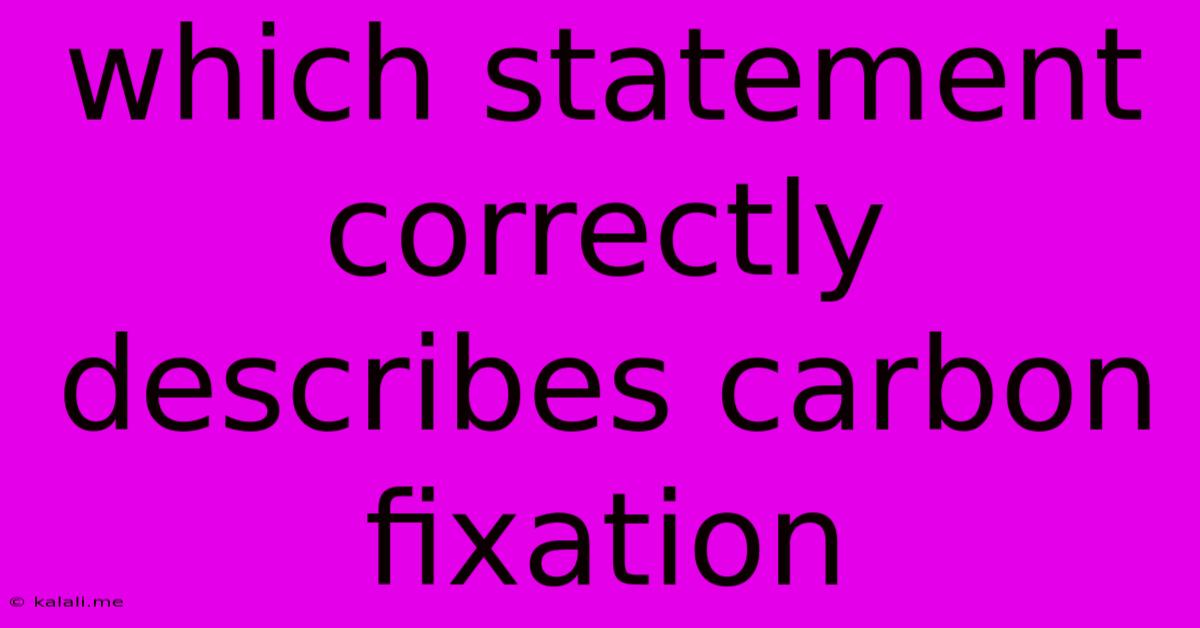Which Statement Correctly Describes Carbon Fixation
Kalali
May 09, 2025 · 3 min read

Table of Contents
Which Statement Correctly Describes Carbon Fixation? Unraveling the Process of Photosynthesis
Carbon fixation, a cornerstone of photosynthesis and the global carbon cycle, is often misunderstood. This article clarifies the process and helps you identify the correct statement describing it. Understanding carbon fixation is crucial for grasping the intricate mechanisms that sustain life on Earth and address climate change challenges.
What is Carbon Fixation?
In simple terms, carbon fixation is the process by which inorganic carbon (primarily carbon dioxide, CO₂) is converted into organic compounds, like glucose. This conversion is vital because it's how plants and other autotrophs obtain the carbon they need to build their tissues and store energy. It's the first step in the Calvin cycle, a crucial part of photosynthesis. Without carbon fixation, life as we know it wouldn't exist.
Understanding the Process
Several key enzymes and molecules are involved in this complex biochemical pathway. The most important is RuBisCO (ribulose-1,5-bisphosphate carboxylase/oxygenase), an enzyme that catalyzes the reaction between CO₂ and a five-carbon sugar called RuBP (ribulose-1,5-bisphosphate). This reaction produces an unstable six-carbon compound that quickly breaks down into two molecules of 3-PGA (3-phosphoglycerate), a three-carbon compound. This is where the "fixation" part happens—the inorganic carbon is incorporated into an organic molecule.
Why is this significant?
- Energy Storage: The 3-PGA molecules then undergo a series of reactions to ultimately produce glucose, a stable sugar molecule that serves as the primary energy source for plants.
- Building Blocks: Glucose and other organic compounds formed during carbon fixation are used as building blocks for various plant structures, from leaves and stems to roots and flowers.
- Global Carbon Cycle: Carbon fixation plays a vital role in the global carbon cycle, removing atmospheric CO₂ and converting it into organic matter. This process is crucial for regulating Earth's climate.
Identifying the Correct Statement:
Given the explanation above, you can now accurately identify a statement that correctly describes carbon fixation. Look for statements that mention:
- Incorporation of inorganic carbon (CO₂) into an organic molecule: This is the essence of carbon fixation.
- The role of RuBisCO: This enzyme is essential for the process.
- Formation of a three-carbon compound (3-PGA): This is a direct product of the initial carbon fixation reaction.
- The connection to photosynthesis and the Calvin cycle: Carbon fixation is an integral part of these processes.
Incorrect Statements to Watch Out For:
Statements that might be incorrect will likely focus on:
- Oxygen production: While carbon fixation is part of photosynthesis, oxygen production is a consequence of a different stage (the light-dependent reactions).
- Release of CO₂: Carbon fixation consumes CO₂, not releases it.
- Direct production of glucose: Glucose is a later product; carbon fixation produces 3-PGA initially.
By understanding the details of carbon fixation, you can correctly evaluate statements about this vital biological process and appreciate its profound significance in the life of plants and the environment. The process is complex but critical to understanding the intricacies of life on Earth and its sustainability.
Latest Posts
Latest Posts
-
How Many Cm Is 9 Feet
May 09, 2025
-
How Many Glasses In 32 Oz
May 09, 2025
-
What Is 6 Liters In Gallons
May 09, 2025
-
What Is The Least Common Multiple Of 12 And 15
May 09, 2025
-
1 As A Power Of 10
May 09, 2025
Related Post
Thank you for visiting our website which covers about Which Statement Correctly Describes Carbon Fixation . We hope the information provided has been useful to you. Feel free to contact us if you have any questions or need further assistance. See you next time and don't miss to bookmark.